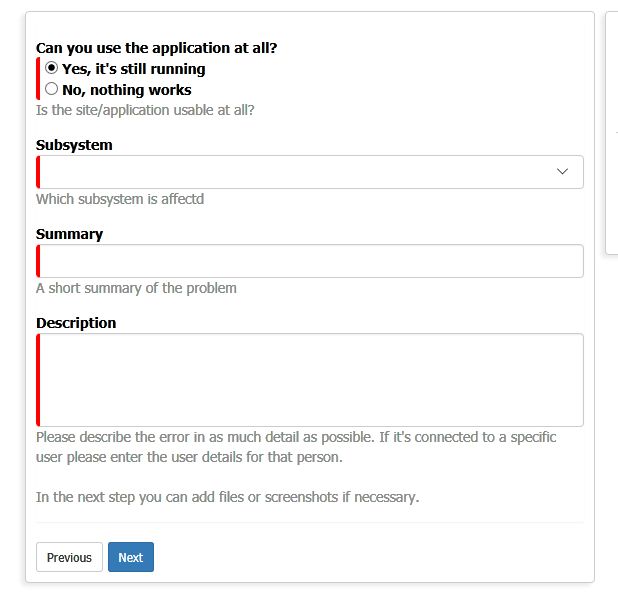-
Posts
813 -
Joined
-
Last visited
-
Days Won
23
Content Type
Profiles
Forums
Enhancement Requests
Posts posted by HHH
-
-
Thanks a lot @Steven, that solved it for me.
-
-
We are experimenting with a single form progressive capture for our customers which looks like this.

I have managed to take the summary field in the form and inject it into the &[global["flowcode"]["summary"]] but is there a way to do the same with &[global["flowcode"]["description"]].
When I try to do it in the Business process description only takes manual text field input (see screenshot).
-
We handle both external and internal customers in our Service Manager instance.
Is there a way to differentiate service catalogue items per portal so that some are only seen on customer.hornbill.com/instance and others only on service.hornbill.com/instance?
I have looked but seem to only be able to differentiate on service level by setting subscriber.
-
Is there any way to allow updateing but not logging of calls through email?
Edit: never mind I just read ALL of the previous post
-
Adding myself to the +1 crowd
-
I have the same problem but use (SR|sr)[0-9]{8} or (IN|in)[0-9]{8} for reference and Rule expression depending on type of call.
I have tried using both REGEX_MATCH(subject, .*(IN|in)[0-9]{8}.*) and REGEX_MATCH(subject, '.*(IN|in)[0-9]{8}.*')
That's with and withoute single quote
-
Some more info. We have another manager attached to that ticket as a member and she can see the ticket as intended.
She is a member of the team that currently has the ticket, other than that they are the same.
A third manager that is not affiliated to any teams is also a member and can view her I'm a member tickets.
All can view the ticket if they go directly to the ticket by editing the URL.
-
Thanks for the quick response I have checked and can verify that that user is present in
h_itsm_requests_membersconnected to the correct request ID. -
Hi, I need some help figuring this out.
We have a request that one of our organisation managers wanted to see despite not being part of the assigned or supporting teams.
So I added him as member to the request.
When he logs in he can see that there is a request but he cannot open or view it. See attached screenshot.
Is this a bug or is there some setting I have missed.
He has the Incident Management User and Collaboration roles and the request is an incident. The request in question is resolved.
-
Adding us to customers (very) interested in scheduling of reports
-
I don't have that role either. Checked system roles, service manager roles, collaboration roles, document manager roles and configuration manager roles. What am I missing?
-
Is it possible to automatically assign each user to a team when importing them through CSV upload for example by adding an organzation ID column?
The wiki https://wiki.hornbill.com/index.php/Users doesn't say anything but if this is possible what should the name of the column to be imported be and how should the format be for the organization?
Organization ID in organizations is in the format company/department/team, could this be used here as well?
-
Just posting to bump this issue. We have the same problem with a large and complex organization and it would help immensely.
I raised another post unaware of this one.
-
 1
1
-
-
I have our internal users set up with the following structure:
-
The Company
-
Division 1
- Team A
- Team B
- Team C
-
Division 2
- Team A
- Team B
-
Division 1
etc..
I want all of Company to be able to subscribe to a service through the Service portal, how do I do that?
I tried just adding "The Company" to subscribers but my user who is in Division 1 > Team A cannot see the service in the service portal in order to log requests to it. What am I missing?
-
The Company
-
I second this proposal. It would be a really good feature to have since we work mostly with external customers where multiple customers may be affected by some systems
-
Thanks, I was looking at custom forms. Sometimes it's easier than you think.
-
We currently have set up a request profile for tickets that is used in reporting. It's a multi level list.
Is it possible to acccess this through the progressive capture and have the customer choose profile directly in the portal?
-
On 2017-08-11 at 7:39 AM, James Ainsworth said:
This operation can also be used as a great way to manage a re-opened request. Once a request has been resolved you can use the Suspend and Wait for Status Change to identify when the request has moved from resolved to being open again, or to closed. In each case a decision node can be used to manage both situations. An Expiry can be used where after a period of time where the status hasn't changed, you can set it to close automatically. This will solve the above issue where re-opened requests were still automatically be closed.
Can you show a BP example of how this can be set up. I like the idea but cannot really follow your description.
-
-
When setting up the endpoint for Jira integration through ibridge how much if the URL do I set as endpoint and how much is added by ibridge itself?
https://domain.atlassian.net/rest/api/latest
https://domain.atlassian.net/rest/api
https://domain.atlassian.net/rest
https://domain.atlassian.net
Endpoint Name is set in KeySafe
-
Thanks all!
-
Do you need to have the "My Boards" role to be able to add a request to a board through a business process.
After today's update I am getting error messages despite requests being successfully added to board.
-
A question about making a CSV import of organisations into a live system where there already customers implemented.
If we already have a number of customers for example CustomerA and CustomerB.
Each have a number of request tickets already.
If I then make a CSV import of CustomerA, CustomerB, CustomerC and CustomerD with CustomerA and CustomerB's information being identical to what's already in the system, will their old request tickets still be connected to them.
That is, is a visible field used as a foreign key in the database.or is there a hidden key that's used so when setting up CustomerA it gets a key of for example 1 and if I add it again from CSV import it gets an ID of for example 3.
I hope I'm somewhat clear. What I'm trying to achieve is to be able to import customers from our sister companies one at a time by appending the new customers to an existing CSV and then re-importing.







Customer organisation with branches and/or consortia
in Service Manager
Posted
I just want some advice and recommendations on how we can handle our customers who have a three layer structure so to say.
Structure is Company -> Branches -> Contact where the contacts can either belong to the different branches or to the overall company itself.
They may have branch staff that creates requests and should only be able to see their branch's requests and also company staff that should be able to see requests from the whole company.
Any ideas?